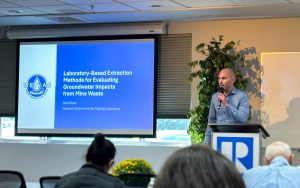Elko (775) 777-9933
Las Vegas (702) 475-8899


 Laboratory-Based Extraction Methods for Evaluating Groundwater Impacts
Laboratory-Based Extraction Methods for Evaluating Groundwater Impacts
Mine waste, if not properly characterized, can significantly impact groundwater quality. Waste rock piles and tailings have the potential to leach metals, acidity, and other contaminants, threatening ecosystems and water resources. Understanding how these materials behave under natural conditions is essential for predicting risks and implementing protective measures.
Why Characterization Matters
Laboratory extraction tests provide valuable insight into how mine waste interacts with water over time. These methods simulate weathering and infiltration under controlled conditions, producing data that informs both risk assessments and regulatory decisions.
Three Key Laboratory Methods
- Meteoric Water Mobility Procedure (MWMP)
A short-term leaching test that mimics the first flush of contaminants during rainfall events. MWMP highlights the immediate risk of soluble salts, metals, and acidity. Regulators often use this procedure as a screening tool to determine if further evaluation is needed.
- Humidity Cell Tests (HCT)
A long-term kinetic test designed to simulate accelerated weathering over weeks to months. HCT provides time-dependent data on acid generation and metal release, offering a conservative estimate of long-term leachate quality.
- Accelerated Diffusion Leach Test
Used primarily for solidified or stabilized waste forms, this method measures contaminant release over time through diffusion. The results allow scientists to model long-term leaching performance and assess the durability of waste stabilization strategies.
The Importance of Sample Preparation
The accuracy of these methods relies heavily on the representativeness of the sample. Proper particle sizing, homogenization, and prevention of contamination ensure that laboratory results reflect real-world conditions. Simply put – garbage in, garbage out.
Key Takeaways
- Mine waste characterization is essential for safeguarding groundwater.
- MWMP, HCT, and diffusion tests each provide unique insights into contaminant mobility.
- Reliable results depend on representative and carefully prepared samples.
- Integrated interpretation—using all three tests in concert—provides the most robust predictions for long-term groundwater protection.
For a deeper dive into the procedures, equipment, and regulatory applications of these tests, you can view the full presentation here: 2025 Laboratory-Based Extraction Methods for Evaluating Groundwater Impacts – NWRA (PowerPoint).
 >
>
